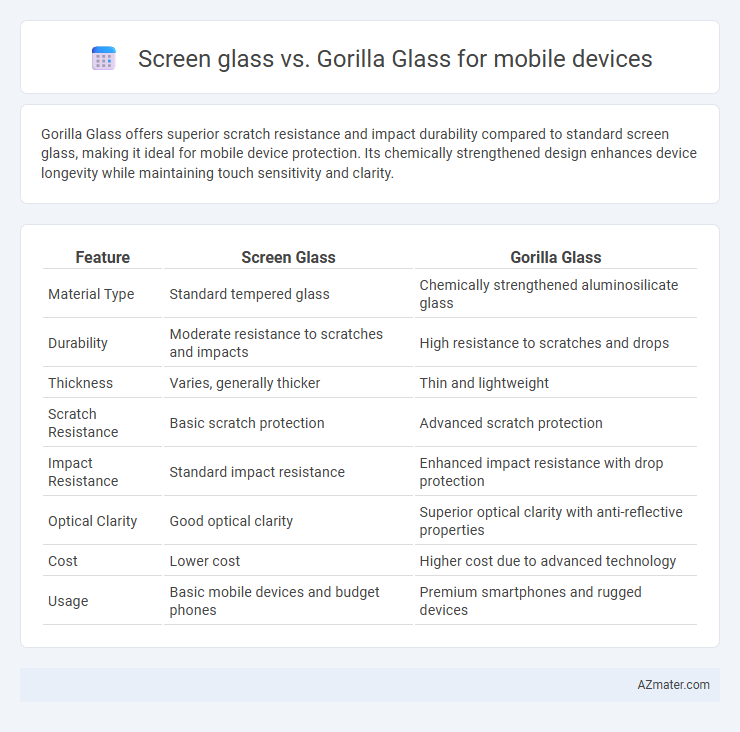Gorilla Glass offers superior scratch resistance and impact durability compared to standard screen glass, making it ideal for mobile device protection. Its chemically strengthened design enhances device longevity while maintaining touch sensitivity and clarity.
Table of Comparison
| Feature | Screen Glass | Gorilla Glass |
|---|---|---|
| Material Type | Standard tempered glass | Chemically strengthened aluminosilicate glass |
| Durability | Moderate resistance to scratches and impacts | High resistance to scratches and drops |
| Thickness | Varies, generally thicker | Thin and lightweight |
| Scratch Resistance | Basic scratch protection | Advanced scratch protection |
| Impact Resistance | Standard impact resistance | Enhanced impact resistance with drop protection |
| Optical Clarity | Good optical clarity | Superior optical clarity with anti-reflective properties |
| Cost | Lower cost | Higher cost due to advanced technology |
| Usage | Basic mobile devices and budget phones | Premium smartphones and rugged devices |
Introduction to Mobile Screen Glass
Mobile screen glass plays a crucial role in protecting the display from scratches, impacts, and daily wear. Gorilla Glass, developed by Corning, is a chemically strengthened aluminosilicate glass known for its high durability, scratch resistance, and thin profile, making it a popular choice for smartphones and tablets. Compared to generic screen glass, Gorilla Glass provides enhanced toughness and clarity, ensuring both protection and excellent visual performance.
What is Standard Screen Glass?
Standard screen glass for mobile devices typically refers to chemically strengthened soda-lime glass, offering basic scratch resistance and durability but lacking the advanced protection against impacts and drops found in Gorilla Glass. Gorilla Glass, developed by Corning, uses an ion-exchange process to create a damage-resistant surface that is thinner, lighter, and more durable than standard screen glass. This engineered toughness enhances touchscreen responsiveness while significantly reducing the likelihood of cracks, making Gorilla Glass a preferred choice for premium smartphones and tablets.
Understanding Gorilla Glass Technology
Gorilla Glass is a specialized, chemically strengthened glass designed by Corning to provide superior scratch resistance and durability for mobile device screens compared to standard screen glass. Its manufacturing process involves ion exchange, where smaller sodium ions are replaced with larger potassium ions, creating a compressive layer that enhances strength and impact resistance. This technology allows devices to maintain clear visibility and touch sensitivity while offering improved protection against drops and scratches.
Composition and Manufacturing Differences
Screen glass for mobile devices typically uses soda-lime glass or aluminosilicate glass, composed mainly of silicon dioxide with additives to enhance durability and clarity. Gorilla Glass, a specific brand by Corning, is an alkali-aluminosilicate sheet glass chemically strengthened through an ion-exchange process that replaces smaller sodium ions with larger potassium ions, increasing surface compressive stress. This manufacturing difference results in Gorilla Glass having superior scratch resistance, impact protection, and thinner profiles compared to conventional screen glass options.
Durability and Scratch Resistance Comparison
Gorilla Glass, developed by Corning, offers superior durability and scratch resistance compared to standard screen glass due to its chemically strengthened aluminosilicate composition. Its enhanced ability to withstand drops and resist scratches makes it a preferred choice for premium mobile devices. Standard screen glass lacks this advanced treatment, resulting in lower impact resistance and increased susceptibility to scratches over time.
Impact Resistance: Standard vs Gorilla Glass
Gorilla Glass offers significantly enhanced impact resistance compared to standard screen glass, utilizing chemically strengthened aluminosilicate layers to absorb and disperse shock from drops and impacts. This advanced composition reduces the likelihood of cracks and scratches, providing superior durability for mobile devices in everyday use. Standard glass lacks this specialized treatment, making it more prone to damage under similar impact conditions.
Cost Implications for Manufacturers and Consumers
Screen glass often costs less than Gorilla Glass, which can reduce manufacturing expenses but may lead to higher replacement costs due to its lower durability. Gorilla Glass, engineered by Corning, offers enhanced scratch resistance and impact protection, increasing the upfront cost for manufacturers but providing long-term savings to consumers through fewer repairs. Manufacturers balance these cost implications by choosing Gorilla Glass to position premium devices, while budget models often utilize standard screen glass to maintain affordability.
Optical Clarity and Touch Sensitivity
Gorilla Glass offers superior optical clarity compared to standard screen glass due to its advanced chemical composition that reduces glare and enhances color accuracy, providing a sharper and more vibrant display. In terms of touch sensitivity, Gorilla Glass features a higher touch responsiveness with minimal latency, enabling smoother and more precise interactions on mobile devices. The durability of Gorilla Glass also maintains consistent performance over time, preventing scratches or damage that can degrade both optical clarity and touch sensitivity.
Real-World Performance and User Reviews
Screen glass in mobile devices typically refers to standard tempered glass, offering decent scratch resistance and durability but prone to chipping under impact. Gorilla Glass, developed by Corning, provides enhanced toughness, improved scratch resistance, and better drop protection verified through numerous user reviews highlighting fewer screen damages during accidental drops. Real-world performance comparisons often show Gorilla Glass maintaining clarity and touch sensitivity longer under heavy use, making it preferable for users seeking reliable daily mobile device protection.
Which Glass is Best for Your Mobile Device?
Gorilla Glass is engineered with chemically strengthened properties that provide superior scratch resistance and durability compared to standard screen glass, making it ideal for protecting mobile devices from everyday wear and tear. Standard screen glass tends to be more prone to cracks and scratches, often requiring additional protective layers or cases to maintain device integrity. Choosing Gorilla Glass enhances the longevity and resilience of your mobile device screen, offering better impact resistance without compromising touchscreen sensitivity.

Infographic: Screen glass vs Gorilla glass for Mobile device
 azmater.com
azmater.com